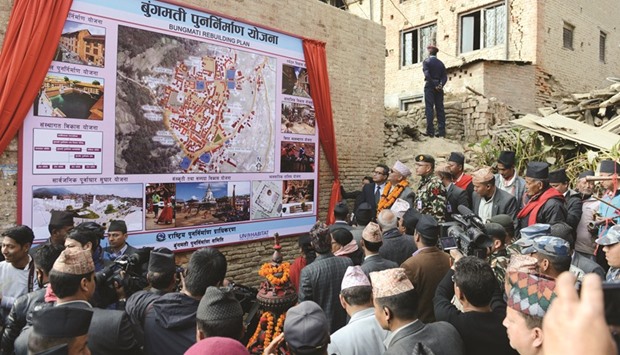Post-earthquake reconstruction was formally begun by the government of Nepal yesterday, nearly nine months after the devastating quakes.
Twin earthquakes in Nepal in April and May killed nearly 9,000 people, according to police, in the country’s worst national disaster.
President Bidhya Devi Bhandari led the symbolic gestures during the ceremony in the capital Kathmandu.
The work will be directed by the National Reconstruction Authority, which took shape in December after wrangling politicians finally agreed on an executive director.
The reconstruction of homes will not begin until April, however, because surveying work is incomplete, the authority said.
The delays have already taken a toll on the displaced, as more than a dozen quake victims reported died in temporary shelter as the Himalayan winter set in.
The international community had pledged $4bn to reconstruction work in Nepal.
Humanitarian agencies have warned that with health care facilities lacking over half of their total essential requirements, the humanitarian implications were “grave”.
A statement signed by four UN agencies and other aid groups said the most vulnerable, including pregnant women, the elderly, children and people with chronic conditions such as diabetes and cardiovascular disease were already being affected.
“Disruptions to public health programmes, including routine immunisation, will have an extremely serious and lasting impact on the health of children,” said the statement from agencies such as the World Health Organisation, Britain’s Department for International Development and the German Development Cooperation.
“Access to life-saving emergency services, including surgery, intensive care and blood transfusion, as well as referrals of complicated cases, have been severely impacted.”
The rising dependence on wood will also increase more indoor pollution and result in a spike in cases of pneumonia.
More than 800,000 Nepali children under five had pneumonia in 2014 and around 5,000 died, said the UN Children’s Fund, Unicef.
But for women like Bhandari, with three mouths to feed, using firewood is her only option.
“For now, my priority is to somehow cook meals and feed my children. Everything else comes after that,” she said.

Nepalese Prime Minister KP Oli, centre left, unveils a poster as he formally begins the reconstruction campaign in Bungamati village on the outskirts of Kathmandu yesterday.
